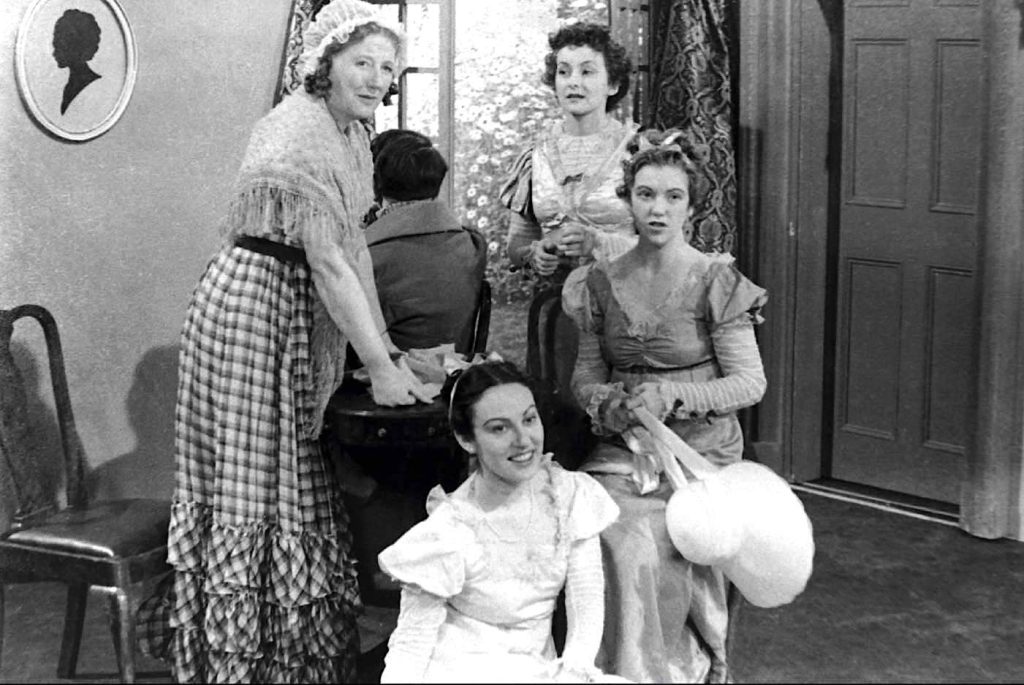OTD in early British television: 22 May 1938

John Wyver writes: British television’s love affair with the works of Jane Austen, which today shows little signs of abating, began 87 years ago today on 22 May 1938, with a 55-minute adaptation of Pride and Prejudice. The fact that this was a Sunday is a pleasing continuity across nearly a century, although television on the Sabbath had started only seven weeks before. (Janeites had been first catered for by radio over a decade earlier, as David Hendy’s recent ‘History of the BBC’ post notes.)
As the rare photograph suggests (there’s no recording), television’s first foray into Austen’s universe had time and space for only three of the Bennet sisters, played by Antoinette Cellier (Jane), Curigwen Lewis (Elizabeth) and Eileen Erskine (Lydia; there was no Mary or Kitty), while Barbara Everest was Mrs Bennet and Allan Jeayes her husband.
Television’s first Mr Darcy was Andrew Osborn, André Morrell was Mr Wickham, Lewis Stringer took the role of Charles Bingley, and Dorothy Green incarnated Lady Catherine de Bourgh. To date, I have found no review of this live presentation [but see Comment below], which was played again on the afternoon of Friday 27 May.
The producer, was also scripted the adaptation, was Michael Barry, who had come from the theatre and joined Alexandra Palace not six months before. In his delightful memoir From the Palace to the Grove (published by the Royal Television Society in 1992), he recalled the experience:
I was scheduled for two further productions within six weeks, and found myself with a growing anxiety about the suitability of theatre plays for television. Looking more widely for subjects of another sort, I made a fifty-five minute version of Pride and Prejudice.
Rashly, I believed it might not take longer to dramatise a movel that I knew so well than conscientiously to adapt a full length theatre play. Today, the audacity is unbelievable but then the world was young and the nights were long.
Barry celebrated his 28th birthday a week before the first transmission.
Perhaps the result… was ‘Scenes from Jane Austin’ [sic], but I hope they were sensible of the period, and possessed an ear for dialogue that allowed the authoress to speak for herself. No script remains but the one existing photograph shows a group of handsomely costumed players who agreed to take part.
Television would not return to Pride and Prejudice until February 1952, when Cedric Wallis adapted the novel into six parts, but there was a single-play version of Emma scripted by Judy Campbell, who also played the title role, in May 1948.
With thanks to the Alexandra Palace Television Society for the photograph.
[OTD post no. 156]
Then having said I could find no reviews, I went to look again, and discovered this account from ‘The Times’ on 30 May 1938:
‘For this production Mrs Bennet’s daughters were reduced in numbers from five to three, and even then, with the most judicious placing, they could only just be fitted in to the opening picture; but it was a very pretty picture of an eighteenth-century family at home in the country, worthy of Jane Austen.
‘Miss Curigwen Lewis, as the sprightly Elizabeth, made the most of her big scenes, both with the formidable Lady Catherine de Bourgh – played bv Miss Dorothy Green in a tremendous bonnet – and with the arrogant Darcy. It says much for Mr. Andrew Osborn’s Darcy that he dominated every scene in which he appeared.
‘The ballroom scenes and the pro vincial country atmosphere were well contrived, and the whole thing was charming, but, of course, it suffered from the intense compression to which it had been subjected.’
PS. [this isn’t from The Times] The future playwright John Whiting, best-known for ‘The Devils’, took the roles of servant, organ grinder and apothecary.